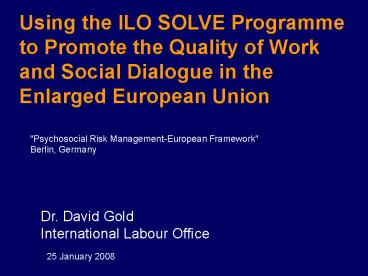1 - PowerPoint PPT Presentation
1 / 27
Title:
1
Description:
Using the ILO SOLVE Programme to Promote the Quality of Work and Social Dialogue in the Enlarged European Union – PowerPoint PPT presentation
Number of Views:96
Avg rating:3.0/5.0
Title: 1
1
Using the ILO SOLVE Programme to Promote the
Quality of Work and Social Dialogue in the
Enlarged European Union
"Psychosocial Risk Management-European Framework"
Berlin, Germany
Dr. David Gold International Labour Office
25 January 2008
2
Case study
- 16-18 years old
- First job
- Lack of experience
- Lack of tacit knowledge
- Lack of formal knowledge
- Strong desire to succeed
3
Hazards
Situation
Level of risk
Outcomes
Physical
- Occupational accidents
- Occupational diseases
- High personal demand
- High professional demand
- Limited or no control over demands
Biological
- Absenteeism, presenteeism, job loss
- Pain, distress, illness
- Disability
- Death
Increased exposures to risks
Chemical
Ergonomic
- Stress (Burnout)
- Violence
- Depression
- Addictions (Alcohol, drugs, smoking, cyber
addiction, gambling) - Inadequate nutrition
- Inadequate exercise
- Strong sexual drive
Psychosocial
4
Can Social Dialogue Play a Role in Reducing the
Risk of Psychosocial Problems Related to Work?
5
Disharmony at Work May Have Many Causes
- It was perhaps not so difficult when all the
workers came for the same village or the same
community. - With the highly mobile workforce of today,
workers may now, in Europe come for different
countries, speaking different languages, with
different cultural values
6
Definition The Ottawa Charter
- Health promotion is the process of enabling
people to increase control over their health and
its determinants. - This is done be strengthening individual skills
and capabilities and the capacity of groups to
change the many conditions, particularly the
social and economic causes, that affect health. - 1986
7
The Karasek Model
Demand
High
Low
High
Control
Low
Source Karasek 1979
8
- The ability of a worker to discuss issues with an
employer, without fear, gives a worker a feeling
of control - A higher perception of control translates into
less stress - Can the reduction of stress lead to a lower risk
of psychosocial problems?
9
Addressing Psychosocial Problems at Work
- An ILO Educational Approach to Formulate a
Comprehensive Policy and Actions at Work to
Address These Problems
10
Examples of the Scope of the Problem
- In Canada, 50 of workers suffer from a high
level of stress (1999, Public Heath Canada). - In Europe, 23 of workers reported overall
fatigue (2000, European Survey on Working
Conditions). - In a US study, 32 of 586 nurses identified
themselves as victims of workplace violence
(Colorado Nurses Assn, 1997). - In a study of 954 New South Wales police
personnel in Australia, 20 would seek advice
from work-place staff about alcohol (1999).
11
The Problem
12
(No Transcript)
13
Expanding SOLVE
14
What SOLVE Addresses of the Top Ten Health Hazards
- Underweight
- Unsafe sex
- High blood pressure
- Tobacco
- Alcohol
- Contaminated water
- Sanitation and hygiene
- Iron deficiency
- Indoor pollution
- High cholesterol and obesity
15
Factors Influencing Psychosocial Issues
Work
The family
The person
16
Focus on the Individual
- For the worker
- higher risk of accident
- increased family or social problems
- stigmatization and discrimination
- deteriorating health
- physical or psychological illness
- pain, distress, disability and death
17
Focus on the Workplace
- For the enterprise or organization
- poor morale
- increased absenteeism, presenteeism, turnover
- reduced productivity
- reduced profits or services
- higher costs
- reduced competitiveness
18
The Goal of SOLVE
Integration of psychosocial issues into a
comprehensive organizational policy and
development of action based on the policy
19
The SOLVE Cycle
Broadening organizational policy through SOLVE to
include psychosocial problems
Identifying specific problems and assessing needs
Evaluating workplace psychosocial problems and
modifying the concept as needed
Implementing workplace action through MicroSolve
modules
20
The SOLVE Programme
The SOLVE methodology moves from concept to
policy to action
- Briefing package for managing directors 2 hours
- The SOLVE policy-level course 4 days
- SOLVE for mid-level managers 3 days
- Course for peer counsellors 2 days
- SOLVE for course directors 5 days
- An introduction to SOLVE for workers 1 hour
- MicroSOLVEs (22) 1.5 hours
21
Adjustment to Culture, Ethnicity and Language
through Simulation
22
Methodology
Each of the SOLVE elements follows an educational
scheme that works in multiple domains of learning
- Building an open attitude towards the subject
- Building a sufficient knowledge base so that the
participant can apply knowledge learnt - Applying the new knowledge through exercises
23
- Within the 32 hour SOLVE Policy Course, there are
twelve hours of role-play simulation exercises. - Participants bring into the simulation exercise
their cultural, ethnic, ethical values and apply
them in a non-threatening policy building
exercise. - The simulation exercise is based on the concept
that through social dialogue, problems can be
solved and both quality and productivity can be
assured.
24
What is the Policy-Level SOLVE Course?
A 32-hour interactive programme for operational
managers
- Provides tools to design a corporate policy
including psychosocial problems - Demonstrates the impact on workers families and
communities - Highly interactive
- case study analysis
- simulation exercises and
- policy development activities
25
Capacity to Organize SOLVE
26
Capacity to Organize SOLVE
- SOLVE has been translated into in the following
languages - English
- French
- Spanish
- Thai
- Portuguese
- Russian
- Bulgarian
- Italian
- Arabic
27
For Further Information
Dr. David Gold SOLVE SafeWork International
Labour Office 1211 Geneva 22 Switzerland Email
solve_at_ilo.org Phone
41-22-799-7515 Fax 41-22-799-6878 Web site
www.ilo.org/safework/solve































